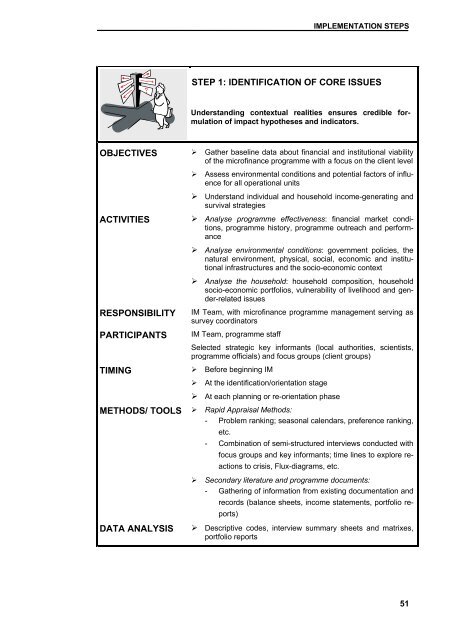Guidelines for Impact Monitoring & Assessment in Microfinance ...
Guidelines for Impact Monitoring & Assessment in Microfinance ...
Guidelines for Impact Monitoring & Assessment in Microfinance ...
You also want an ePaper? Increase the reach of your titles
YUMPU automatically turns print PDFs into web optimized ePapers that Google loves.
OBJECTIVES<br />
ACTIVITIES<br />
RESPONSIBILITY<br />
PARTICIPANTS<br />
IMPLEMENTATION STEPS<br />
STEP 1: IDENTIFICATION OF CORE ISSUES<br />
Gather basel<strong>in</strong>e data about f<strong>in</strong>ancial and <strong>in</strong>stitutional viability<br />
of the microf<strong>in</strong>ance programme with a focus on the client level<br />
Assess environmental conditions and potential factors of <strong>in</strong>fluence<br />
<strong>for</strong> all operational units<br />
Understand <strong>in</strong>dividual and household <strong>in</strong>come-generat<strong>in</strong>g and<br />
survival strategies<br />
Analyse programme effectiveness: f<strong>in</strong>ancial market conditions,<br />
programme history, programme outreach and per<strong>for</strong>mance<br />
Analyse environmental conditions: government policies, the<br />
natural environment, physical, social, economic and <strong>in</strong>stitutional<br />
<strong>in</strong>frastructures and the socio-economic context<br />
Analyse the household: household composition, household<br />
socio-economic portfolios, vulnerability of livelihood and gender-related<br />
issues<br />
IM Team, with microf<strong>in</strong>ance programme management serv<strong>in</strong>g as<br />
survey coord<strong>in</strong>ators<br />
IM Team, programme staff<br />
TIMING Be<strong>for</strong>e beg<strong>in</strong>n<strong>in</strong>g IM<br />
Selected strategic key <strong>in</strong><strong>for</strong>mants (local authorities, scientists,<br />
programme officials) and focus groups (client groups)<br />
At the identification/orientation stage<br />
At each plann<strong>in</strong>g or re-orientation phase<br />
METHODS/ TOOLS Rapid Appraisal Methods:<br />
- Problem rank<strong>in</strong>g; seasonal calendars, preference rank<strong>in</strong>g,<br />
DATA ANALYSIS<br />
Understand<strong>in</strong>g contextual realities ensures credible <strong>for</strong>mulation<br />
of impact hypotheses and <strong>in</strong>dicators.<br />
etc.<br />
- Comb<strong>in</strong>ation of semi-structured <strong>in</strong>terviews conducted with<br />
focus groups and key <strong>in</strong><strong>for</strong>mants; time l<strong>in</strong>es to explore re-<br />
actions to crisis, Flux-diagrams, etc.<br />
Secondary literature and programme documents:<br />
- Gather<strong>in</strong>g of <strong>in</strong><strong>for</strong>mation from exist<strong>in</strong>g documentation and<br />
records (balance sheets, <strong>in</strong>come statements, portfolio re-<br />
ports)<br />
Descriptive codes, <strong>in</strong>terview summary sheets and matrixes,<br />
portfolio reports<br />
51

















![CynefinFramework final [Read-Only]](https://img.yumpu.com/19017304/1/190x135/cynefinframework-final-read-only.jpg?quality=85)